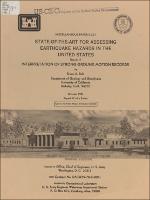Please use this identifier to cite or link to this item:
https://hdl.handle.net/11681/20748| Title: | State-of-the-art for assessing earthquake hazards in the United States. Report 17, Interpretation of strong ground motion records |
| Authors: | University of California, Berkeley. Department of Geology and Geophysics Soils and Pavements Laboratory (U.S.) Bolt, Bruce A., 1930-2005 |
| Keywords: | Earthquake engineering Earthquake hazards Earthquake risk Earthquakes Earthquake resistant design Ground motion Seismology Data processing |
| Publisher: | Geotechnical Laboratory (U.S.) Engineer Research and Development Center (U.S.) |
| Description: | Miscellaneous Paper Abstract: In this report, an attempt is made to extend the usual seismological analyses of seismograms to strong-motion records. A description is given of the main patterns of motions recorded on accelerograms near to the causative fault in terms of P and S waves and Love and Rayleigh waves. In order to achieve this, the effects of source dimensions and the physical and kinematical properties of the fault zone are included in the analysis. The two main aims of the work were, first, to make an initial step toward the routine interpretation of the recorded strong ground motions and, as a consequence, to provide a basis which would allow ground motions in future large earthquakes to be predicted. Both aspects of strong-motion seismology are of interest to the engineering profession for the design of critical structures in earthquake country, such as large dams and bridges. The research has been based on the detailed study of near-field records obtained in moderate to large earthquakes in the last few decades. In particular, analysis is made of strong-motion records of 10 important earthquakes that includes: the 1952 Kern County, California, earthquake; the 1971 San Fernando, California, earthquake; the 1972 Managua, Nicaragua, earthquake; the 1977 Romania earthquake; the 1979 Imperial Valley, California, earthquake; and the 1980 Livermore Valley, California, earthquake. The analysis works from first physical principles and, so far as possible, uses elementary ray theory and kinematic arguments. Nevertheless, elements of the more sophisticated theory of earthquake mechanisms and seismic wave propagation in the near field were taken into account in the interpretive work. As a special part of the present analysis, field studies were made of the 1979 Coyote Lake, the 1979 Imperial Valley, and the 1980 Livermore Valley earthquakes in California. A program was written to convert strong-motion accelerometer records into standard Wood-Anderson records, and it is demonstrated how this transformation assists in wave interpretations. Other special parts of the work involved finite element analyses to investigate the effect of trenches and scarps on the propagation of seismic waves and the computation of seismic moment from near-field records. Finally, some empirical rules are developed for the construction of representative seismograms for strong ground motions, given information on the seismic source and distance to the site. |
| Rights: | Approved for public release; distribution is unlimited. |
| URI: | http://hdl.handle.net/11681/20748 |
| Appears in Collections: | Miscellaneous Paper |
Files in This Item:
| File | Description | Size | Format | |
|---|---|---|---|---|
| TR-S-73-1-Report-17.pdf | 17.01 MB | Adobe PDF |  View/Open |